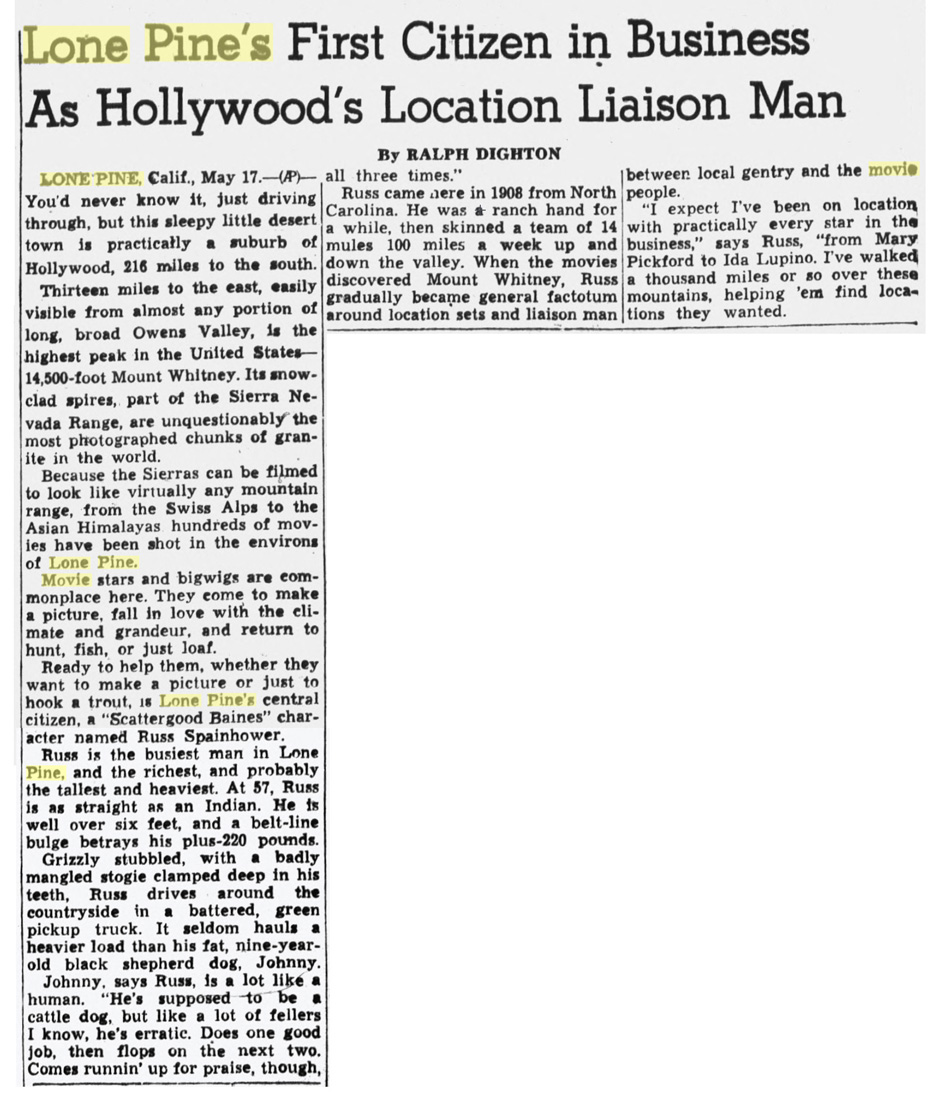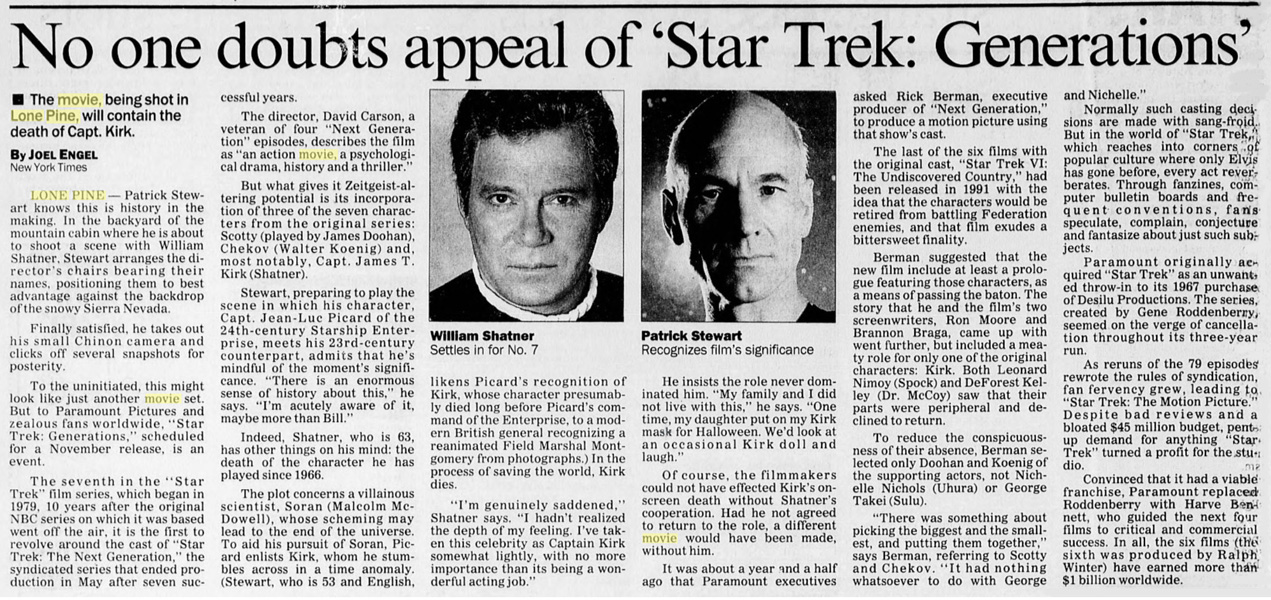



























|
|
![]()
Note: "OLLP" at then end of a text block indicates the text was taken from On Location in Lone Pine by Dave Holland. |
![]()
Lone Pine Film History Museum
Lone Pine, Where the Real West Becomes the Reel West
![]()
Movies/Documentaries/TV Series Filmed in Owens Valley
![]()


![]()
![]() 10/24
10/24
 |
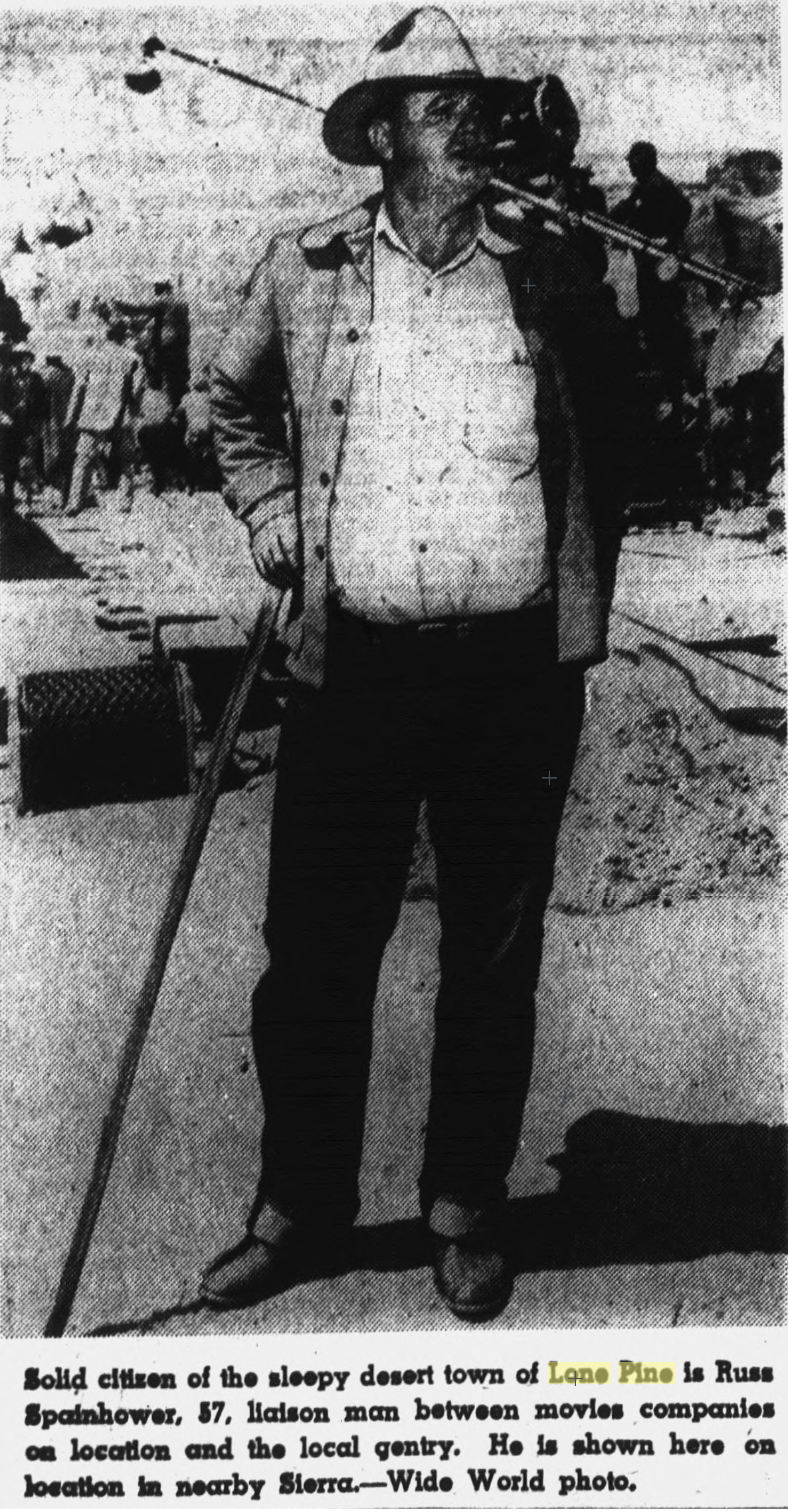 Russ Spainhower - Lone Pine's liaison to Hollywood |
![]()
Alabama Hills Movie Road Self-Guided Tour
by Sam Lewis
![]()
![]()
The Western Stars |
|||
Adele Mara 1923-2010 |
|||
 |
Ann Little 1891-1984 |
||
 |
Billy Dove 1903-1997 |
||
 |
Verna Hillie 1905-1983 |
||
 |
|||
Carmelita Geraghty 1901-1966 |
|||
 |
|||
Dorothy Revier 1904-1993 |
|||
 |
|||
Geneva Mitchell 1907-1949 |
|||
Rhonda Fleming 1923- |
|||
 |
|||
Gail Davis 1925-1997 |
|||
Donna Douglas 1933- |
|||
 |
|||
Gene Tierny 1906-1935 |
|||
Raquel Welch 1940 - |
|||
 |
|||
Jane Russell 1921-2011 |
|||
Jane Fonda 1937- |
|||
Gloria Henry 1923- |
|||
 |
|||
Ann Margaret 1941- |
|||
 |
|||
Charlene Holt 1919-1980 |
|||
 |
|||
Virginia Mayo 1920-2005 |
|||
 |
|||
Mala Powers 1931-2007 |
|||
|
|||
Julie Adams 1926- |
|||
 |
|||

Five Guns West - 1955
(Alternate: A, B)
 |
 From the "Oceanside Daily Blade-Tribune" of April 2, 1951 Susan Hayward and Tyrone Power in "Rawhide" - made on location in Lone Pine, CA. |
Obviously, many place names hereabouts came from the names of pioneers and explorers who came to the valley more than 100 years ago. It was only natural that the men making those first maps (and faced with dozens of nameless rivers and mountains and valleys) named many of them after themselves or people in their own expeditions. Certainly that was true for the Owens Valley itself (and the same-named river and lake). Here's that story: It was the search for beaver, gold and silver - any of which could earn men fortunes - that brought about the discovery and settlement of the valley. Mountain man Joseph Walker was the first white man to enter the Owens Valley. In 1833, trappers in Salt Lake City wanted to invade the massive Sierras but the vast desert was a flat but awesome barrier. Walker was an experienced trapper and trail blazer so was hired to go exploring, to find routes from Salt Lake to California and back. He crossed the Sierras to Monterey and the following February, set out on the return trip. He followed the Kern River out of the San Joaquin Valley, crossed the mountains over the pass name named for him (down near Inyokern, east of Bakersfield) and swung north into what is now the Owens Valley. But the valley wasn't name on that trip, nor did Walker find any beaver, by the way. But he did discover Yosemite Valley and pioneered the Salt Lake-Humboldt trail, later a vital immigrant route. In 1845, Captain John Fremont was still exploring the west and hired Walker to lead a mapping group south through the valley. When the Mountain Man rejoined Fremont in San Jose, they talked of the grandeur of the mountains from the eastern side and of the large brackish alkaline lake Walker must have been accustomed to passing by now (he had been through there again as recently as 1843, guiding the Chiles wagons, which he had to abandon near the lake due to the exhaustion of the mules and the party being under-supplied.) As they worked on their maps, Fremont named that lake after one of his party's valuable hunters, Richard Owens. Ironically, Owens never saw the lake or the river, much less the valley, named after him. OLLP |
 |
Filming Sites in the Alabama Hills and Owens Valley - Courtesy of Kevin Closson Kevin has such a wealth of filming site information on his website that you MUST visit it! I am only giving you a glimpse of what he has. |
|

Southeast of Lone Pine, on the other side of Owens Lake is the lively ghost town of Cerro Gordo. The name is Spanish for "Fat Hill," which undoubtedly had nothing to do with anything rotund but meant fat with silver. Some Mexican prospectors (Pablo Flores is one of the names remembered) found silver here in 1865 and in its peak year, 1874, its three smelters turned out 5,300 tons of bullion worth $2,000,000. Its total production (well into this century) totalled $17,000,000. And it was to speed up the process of getting all that silver down to Los Angeles that something truly remarkable went on. As hard as it is to look at the quiet and "empty" Alabama Hills today and envision literally hundreds of actors and horses and technicians scurrying like ants all over them, it is equally impossible (for me, anyway) to drive by the parched Owens Dry Lake and picture boats chugging back and forth. Boats in the desert? You betcha. The Owens Lake is (or was) the natural collection point for all the streams flowing into the Owens Valley. Before the Los Angeles Aqueduct (completed in 1913) diverted the river water, the lake covered 100 square miles and was at places 30 feet deep. And in the 1870's, today's tiny Cartago was a bustling port town! The 85-foot Bessie Brady brought silver bullion from the Cerro Gordo mines to the landing at Cartago where Remi Nadeau's celebrated 14 to 20-mule teams took it on down to Los Angeles. On the return trips, those freight wagons would bring food, grain, machinery, etc. up across the blistering Mojave for the mines. Later, a second steamboat called the Molly Stevens also towed barges across the middle of the lake. And even those two boats have stories behind their names. The Bessie Brady was built in 1872 by James Brady and named for his daughter who christened the new boat at Ferguson's Landing that July 4th. The next year, since the mines at Cerro Gordo needed wood and plenty of charcoal for its smelters, Colonel Sherman Stevens built a sawmill and flume in Cottonwood Canyon where trees were plentiful and shipped his lumber, mine timbers, etc. across the lake first on barges behind the Bessie Brady, then later on the Molly Stevens, built in 1877 by Stevens and named after his daughter. During this period, Olancha got into the act, too. It maintained large corrals for all those freight teams, which kept Cartago from clogging up. Some of those cottonwoods in Olancha, incidentally, were transplanted from Cottonwood Creek in the 1880's by a pioneer rancher to help make it the shady roadside stop it is today and was when it was a way station for the Owens Valley-Mojave stage. OLLP |
 |
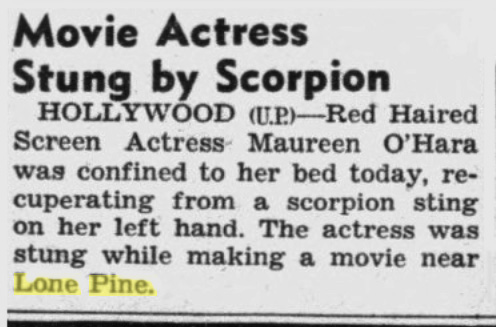 From the "Salinas Californian" of May 3, 1951 Actress Maureen O'Hara confined to be after being stung by a scorpion while filming in Lone Pine. |
 |
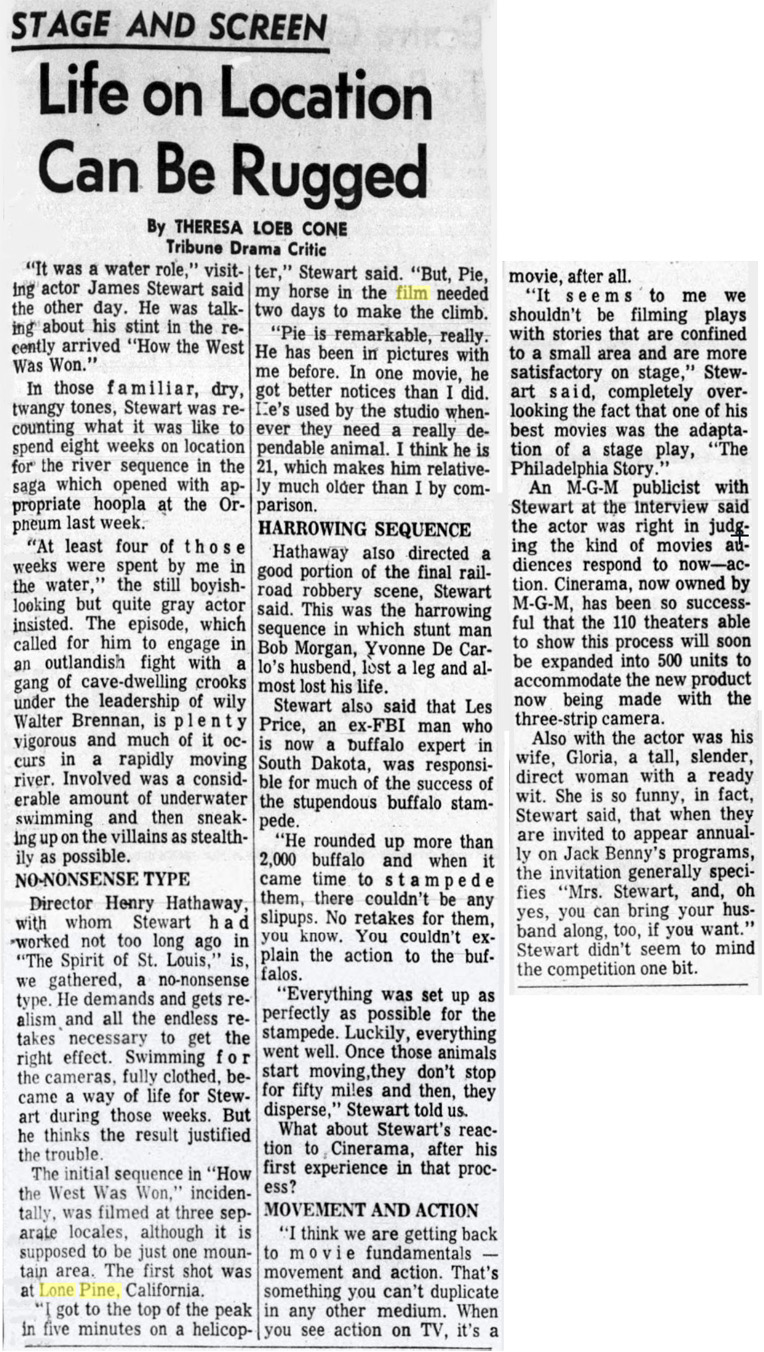 From the "Oakland Tribune" of March 5, 1963 "Life on location can be rugged" - Filming "How The West Was Won" in Owens Valley |
Charles Putnam built a stone cabin along Little Pine Creek. The trading post he established there is acknowledged as the beginning of what would become the town of Independence. But where did the name "Independence" come from? That story, too, has a natural progression. As other homesteaders came into the growing settlement, the first name change took place. The growing settlement they'd called merely Putnam's became Little Pine (after the creek). Then during that very hard winter of 1861-1862, fights with the Paiutes began. Hungry Indians butchered some cows, the settlers retaliated and a war was on, a war that would last a year and a half (but even as late as 1865, one pioneer family's diary recorded that "a horseman came rushing up and said that Indians had killed a woman and her son about 50 miles south of Lone Pine and were coming up the Valley.") To Protect the settlers, the Army established a garrison near Little Pine in the summer of 1862. The soldiers arrived on the 4th of July and made camp along Oak Creek; you can still see the caves where they lived while putting up their buildings. And as you have probably guessed, it was to commemorate their arrival on Independence Day that the new post was called ... Camp Independence. It was in 1866 that Little Pine changed its name to Independence on the occasion of the town becoming the county seat - which it still is. But before the Army got there, that fight in the Alabama Hills took place. The plan didn't work but the settlers were hoping that the Indians' cattle rustling could be nipped in the bud if a swift and decisive blow were struck at a main camp. In February of 1862, some two dozen settlers made a night march from Putnam's and at sunrise, attacked the Paiutes at a winter camp in the Alabama Hills, destroying much of their food reserves (more than a ton of dried meat). The attack was probably out in the valley rocks (rather than in the rounded hills) because in describing the fight, pioneer Bart McGee wrote that when the Indians ran for shelter, they ducked into "cavities where they were out of sight in less than 30 seconds. (We shot) into the mouths of their dens while (they shot arrows at us) in showers .... They did not have guns or they would have made a hard fight for us." Think about that when you're out hiking in those same rocks. And the sheriff getting shot through the door and those stagecoach hold-ups and the saloon shootings when next you're watching a Hopalong Cassidy film. The movie-makers maybe didn't know it, but what they were doing had all happened before. For real. Right here. OLLP |
||
 |
||
 |
 From the "Madera Daily News-Tribune" of April 21, 1954 Constable Oscar Burkhardt imposes curfew in Lone Pine because of 86 beautiful starlets. |
Movies Filmed in Owens Valley |
||
| Monache Meadows Cowboys | ||
Sam Lewis & Sierra Lady Pack Station |
||
| Ed Brown - Mt. Whitney Pack Trains Packer and Cowboy Poet | ||
More At the Movies ... in Lone Pine |
Sign Guestbook View Old Guest Book Entries Oct 1999 - Feb 2015 (MS Word) |
 CONTACT the Pigmy Packer |
View Guestbook View Old Guest Book Entries Oct 1999 - Feb 2015 (PDF) |



